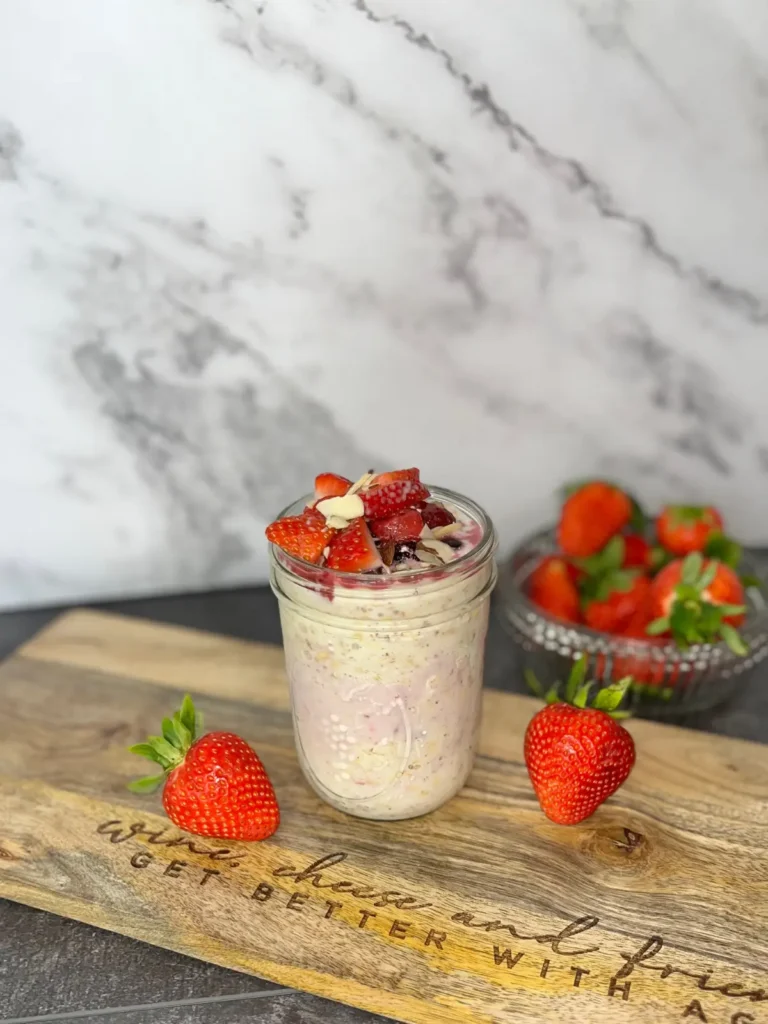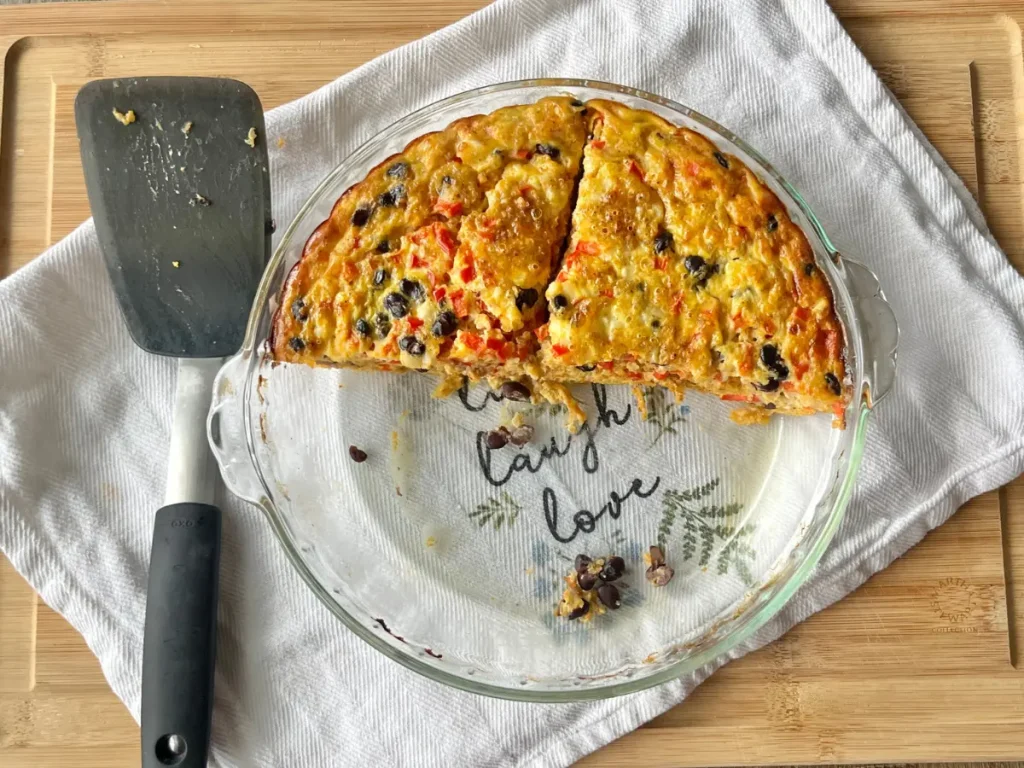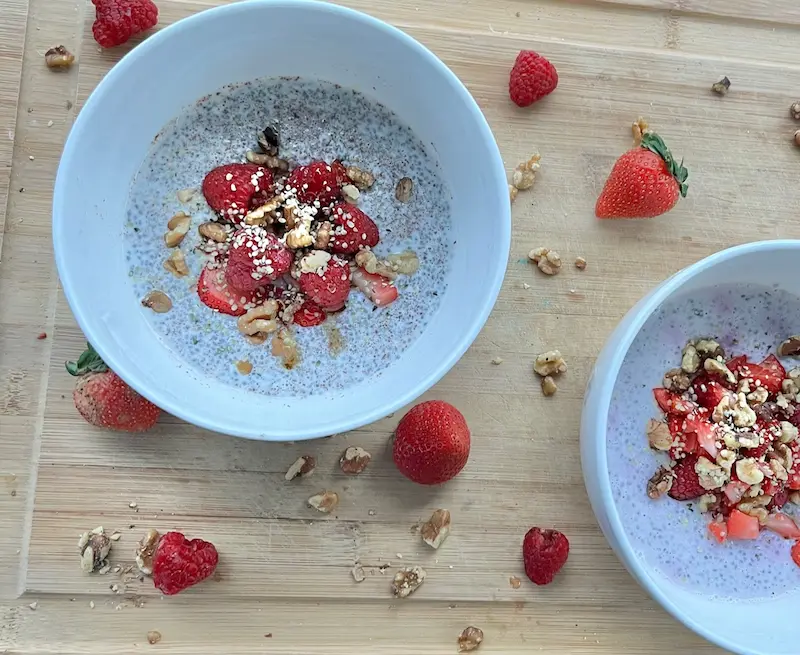As if you didn’t have enough to worry about while carrying a child, now you’ve been diagnosed with gestational diabetes. With all the nutritional recommendations and restrictions out there on the internet, it can seem quite confusing. In this post, I will share 13+ breakfast ideas for gestational diabetes along with guidelines on how to build a healthy breakfast.

Becoming mindful of your food choices may sound daunting, but it is very important. Poorly controlled blood sugar with gestational diabetes can have lasting effects on both the mother and the fetus – even after birth. Research has found that it increases the risk of Type 2 diabetes and cardiovascular disease in both the mother and the baby, with a larger susceptibility of childhood overweight and obesity.
So let’s go over what the current guidelines are saying, the fundamentals of building a breakfast for gestational diabetes, and breakfast ideas with the macronutrient breakdown listed!
Carbohydrate Recommendations for Gestational Diabetes
The specific guidelines for carbohydrate consumption for gestational diabetes is a bit controversial. You might think that once you get diagnosed it’s time to start restricting carbohydrates, however, this is not the case.
Most organizations recommend that carbs should make up 35-45% of total calories, often at least 175 grams of carbohydrates per day, distributed in three small-to-moderate sized meals and 2-4 snacks. However, these recommendations do vary.
The American Academy of Nutrition and Dietetics recommends 158 grams of carbohydrates per day, and 28 grams of fiber. They specify that the amount and type of carbohydrate should be individualized based on nutrition assessment, treatment goals, and blood sugar.
Next – the American College of Obstetricians and Gynecologists recommends complex carbohydrates over simple carbohydrates, as they are digested more slowly and less likely to produce spikes in blood sugar.
Therefore, the suggestion is more consistent carbohydrate consumption throughout the day with increased intake of complex carbs. Carbohydrate restriction may ultimately lead to inadequate caloric intake – which is not recommended during pregnancy. Even for those with gestational diabetes, calorie restriction during pregnancy may have adverse side effects on birthweight.
The Difference between complex and simple carbohydrates
Complex carbs contain fiber and starch, while simple carbs consist of mostly sugar. The reason complex carbohydrates are so important is because they take a longer period of time to digest – thus, releasing glucose into the bloodstream at a slower pace.
Examples of complex carbohydrates include fruits, non-starchy vegetables, beans, whole wheat bread, pasta, rice, barley and quinoa. Simple, refined carbohydrates include most processed foods and packaged snacks, soda, pre-packaged cereals, fruit juice concentrate, cakes and cookies.
In summary, research suggests that women with gestational diabetes should choose more complex carbohydrates with a low-glycemic index. Compare food labels of different foods to determine higher fiber options. For example, brown rice versus white rice.
Building a Gestational Diabetes Breakfast
When assembling a gestational diabetes-friendly breakfast, you should consider these four guidelines:
– 300-500 calories
– Include at least 20 grams of protein
– Aim for 30 to 45 grams of complex or high fiber carbohydrates
– Add in fruit or vegetables when you can

Calorie needs are slightly increased in both the second and third trimester, which is when you typically are diagnosed with gestational diabetes.
Therefore, I recommend 300-500 calories at breakfast to ensure you’re meeting these needs. However, this may vary based on pre-pregnancy BMI, your blood sugars, weight gain throughout your pregnancy, and calorie distribution throughout your day.
Having an adequate protein source helps to stabilize your blood sugar, so it is essential to include one at each meal. Protein needs are also increased during pregnancy. Consuming 20-30 grams of protein at each meal should be the goal to help reach your needs.
Related Posts:
— 15 Lunch Ideas for Gestational Diabetes
— Grocery List Staples for Pregnancy
— What to Eat When Your Pregnant and Nauseous
Breakfast Ideas for Gestional Diabetes
Here are 13+ breakfast ideas for gestational diabetes, so you have plenty of variety to choose from!
If you’re a working woman or busy mom, it might be difficult to prepare some of these items every morning. Therefore, meal prepping in advance might help to ensure you’re eating an adequate breakfast for GDM.
1. Eggs, Toast and Strawberries; 350 calories, 44 g of carbohydrates, 24 g protein
- 2 eggs, scrambled (0 g of carbohydrates) –> Best practice is to fully cook eggs or use pasteurized eggs. If you will only eat your eggs runny, the risks outweigh the benefits – the chance of getting salmonella is very small!
- 2 slices of 100% whole wheat toast (18 g of carbohydrates per slice)
- 1/2 cup of strawberries (8 g of carbohydrates) or 1/2 avocado

Add a little shredded cheese, and make this a sandwich if you like. Omit the strawberries, and add some veggies to the scramble as a substitute.
For a vegan option, opt for a tofu scramble in replace of the eggs. Just a half cup of tofu consists of 21 g of protein!
2. Egg and Cheese Burrito; 510 calories, 34 g of carbohydrates, 28 grams protein
- 2 eggs, scrambled (0 g of carbohydrates)
- 12″ high fiber tortilla (25 g of carbohydrates per slice)
- 1/2 avocado (8 g of carbohydrates)
- 1/4 cup shredded cheese (1 g of carbohydrate)
A very filling, substantial breakfast that will likely hit the spot. Omit the avocado, and meal prep a few of these in advance. Heat in the microwave on the day you want to consume, add in the avocado, and wrap in aluminum foil to take with you to work if needed.
3. Veggie Egg Frittata or Quiche with Toast; 512 calories, 37 g carbohydrates, 31 g protein
- 1 serving vegetable frittata (7 g of carbohydrates)
- 1/2 100% whole wheat bagel (25 g of carbohydrates per slice)
- 1 cup of skim milk (12 g of carbohydrates)
A glass of milk is added to meet the carbohydrate limit for this breakfast, which also contains calcium – a very essential nutrient during pregnancy.
Follow a recipe that contains at least 6 eggs. For this breakfast, I used this Vegetable Frittata Recipe which yields 4 servings.
4. Quinoa Egg Cups; 316 calories, 42 g carbohydrates, 20 g protein
- 2 quinoa egg cups (24 g of carbohydrates)
- Slice of whole wheat toast (18 g of carbohydrates per slice)
There are many variations to quinoa egg cups. I used this recipe from Sweet Peas and Saffron for reference. Most recipes use a muffin tin, and yield 12 muffins or egg cups. They are perfect to freeze for later use on busy mornings.
5. Cottage Cheese, Egg, Avocado Toast; 470 calories, 31 g carbohydrates, 27 g protein
- One egg, any style (0 g of carbohydrates)
- 1/2 cup low-fat cottage cheese (5 g of carbohydrates)
- Slice of whole wheat toast (18 g of carbohydrates per slice)
- 1/2 sliced or mashed avocado (8 g of carbohydrate)
Toast a piece of bread in the toaster, and top with cottage cheese, an egg, and avocado for a delicious, well-balanced breakfast. Add any spices or seasonings of your preference.
6. Cottage Cheese Toast with Honey; 300 calories, 30 g carbohydrates, 30 g protein
- 1/2 cup of whipped cottage cheese (5 g of carbohydrates)
- One slice of whole wheat toast (5 g of carbohydrates)
- About 1 teaspoon of honey (8 g of carbohydrates)
- One cup of skim milk (12 g of carbohydrates)
Toast a slice of wheat bread, top with whipped cottage cheese and a drizzle of honey. Add red pepper flakes for some heat, or use hot honey instead of regular honey.
7. High Protein Pancakes; 300 calories, 45 g carbohydrates, 20 g protein

- Three Kodiak Power Cakes (30 g of carbohydrates)
- 1/2 container of Chobani Zero Sugar Greek yogurt mixed with 1 Tbsp. of maple syrup (15 g of carbohydrates)
The Greek yogurt adds additional protein to the meal, but also brings delicious flavor. Top each pancake with some of the Greek yogurt and maple syrup mixture. Select any Greek yogurt flavor you want! Garnish with strawberries.
Substitute with zero sugar maple syrup, and use the entire container of Greek yogurt as well.
8. Greek Yogurt Parfait; 320 calories, 40 g carbohydrates, 19 g protein

- 3/4 cup Chobani Zero Sugar Vanilla Greek Yogurt (6 g of carbohydrates)
- 1 sliced banana (28 g carbohydrates)
- 2 Tbsp. chopped walnuts (2 g carbohydrates)
- 2 Tbsp. ground flaxseeds (4 g carbohydrates)
A simple and easy Greek yogurt parfait with the addition of flaxseeds, which provide omega-3 fatty acids (often lacking in most pregnancy diets). Substitute the banana for 1 cup of strawberries or peaches for a bit less carbohydrate content.
9. Protein Smoothie; 382 calories, 45 g carbohydrates, 30 g protein

- 1 scoop protein powder of your choice (1 g carbohydrate)
- 1 medium banana (28 g carbohydrates)
- 1/2 cup frozen avocado chunks (4 g carbohydrates)
- 2 Tbsp. ground flaxseeds (4 g carbohydrates)
- 1/2 teaspoon of honey (3 g carbohydrates)
- 1/2 cup skim milk (5 g carbohydrates)
Combine all ingredients and blend. Smoothies are ideal for those busy morning with very little time, or for those who have very little appetite and prefer to drink their breakfast.
Also try my Dark Cherry Cottage Cheese Smoothie (tastes like cheesecake) which provides 245 calories, 29 g carbohydrates, and 15 g protein. Adding 1/2 scoop of protein powder would be ideal to increase the protein of this particular recipe.
10. Peanut Butter Overnight Oats; 420 calories, 38 g carbohydrates, 27 g protein
- 1/2 cup steel cut or rolled oats (27 g of carbohydrates)
- 2 Tbsp. peanut butter (5 g carbohydrates)
- 1 container (150g) Chobani Greek yogurt (5 g carbohydrates)
- 1 cup unsweetened almond milk (1 g carbohydrates)
Combine all ingredients, and let sit overnight in the refrigerator. Overnight oats can be an excellent breakfast option with many variations. Just ensure the recipe is high in protein for blood stabilization by adding peanut butter, protein powder and/or the Greek yogurt. A teaspoon of honey or sugar substitute could be added for sweetness.
Also try: Berry Cheesecake Overnight Oats or one of these 20+ Overnight Oats Recipes.

11. Oatmeal with Milk; 340 calories, 35 g carbohydrates, 25 g protein
- 1/2 cup steel cut oats or rolled oats (28 g carbohydrates)
- 1 cup unsweetened almond milk (1 g carbohydrates)
- 1 scoop of protein powder (1 g carbohydrates)
- 1/2 cup berries (5 g carbohydrates)
Simply combine all the ingredients and microwave for two minutes (may vary). A well-balanced breakfast idea that is quick and easy to prepare. Pro Tip: Instant oatmeal has a higher glycemic index and glycemic load than rolled or steel cut oats.
12. Savory Quinoa Breakfast Bake; 383 calories, 33g carbohydrates, 26.5g protein

This is an easy, high protein quinoa breakfast bake that makes great leftovers! Make it on a Sunday, and have a filling breakfast prepped for up to 4 days!
13. Chia Breakfast Bowl; 400 calories, 41g carbohydrates, 22g protein
Another super simple breakfast prep recipe that’s high in fiber to help with blood glucose stabilization. This chia breakfast bowl packs a nutritional punch and tastes refreshing!

Also read: Gestational Diabetes Lunch Ideas.
Reading Food Labels
Learning how to read food labels when diagnosed with gestational diabetes can be essential in controlling your blood sugars throughout the day. This is especially true if you don’t know which foods contain carbohydrates.
Compare the carbohydrate, and specifically fiber, content of different products. For example, one loaf of bread may have 15 grams of carbs per slice – while others are 19 grams. One may be higher in fiber as well.
Free Printable
Download this free printable which includes some breakfast ideas listed in this post, as well as some suggested guidelines on building a gestational diabetes breakfast.
Some Additional Thoughts
So there you have it! Breakfast ideas and the tools needed to put together your own ideas based on you and your family’s preferences.
It may be trial and error on which foods cause your blood sugar to be higher, and how many carbohydrates are best for you to consume at each meal. Again, these breakfast ideas are just a guideline – the recommended number of carbs to eat per meal is still unclear.
This post is not meant to replace medical advice from a physician or dietitian you are working with one on one. Although I am a Registered Dietitian and all information is evidence-based, treatment for gestational diabetes is often individualized.
